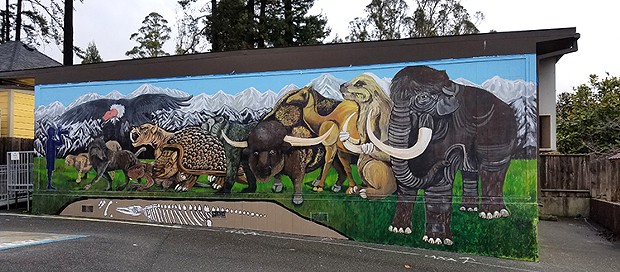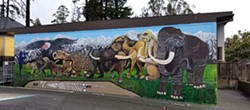[
{
"name": "Top Stories Video Pair",
"insertPoint": "7",
"component": "17087298",
"parentWrapperClass": "fdn-ads-inline-content-block",
"requiredCountToDisplay": "1"
}
]
Armored glyptodontids and giant sloths feature in Arcata's newest work of public art — and no, that's not a metaphor. Pleistocene megafauna have returned to G Street in life-size reproduction and the city's newest mural, generously scaled as it is at 12 by 39 feet, can barely contain them.
"Pleistocene Era Megafauna of the Pacific Northwest," which takes up one side of Humboldt State University's Natural History Museum's (1242 G St.) new classroom trailer, was completed last month after three months of work. Art education professor James Woglum, who coordinated 36 HSU art education students in the painting effort, pointed out that the megafauna may actually be making their first appearance here, geographically speaking, since the place we now call Arcata was underwater during the Pleistocene.
The mural bears no explanatory text (there are plans to add some in future), so identification of the 11 species shown currently poses armchair taxonomists with a challenge. I was able to identify giant sloth, giant beaver, short-faced bear and wooly mammoth, among others. All are rendered in a vigorous, enthusiastic style. Minor expressionist exaggerations communicate a gee-whiz sense of wonder that suits the theme.
During the Pleistocene era, which lasted from about 2,588,000 to 11,700 years ago, enormous furry mammals held sway while portions of whole continents were locked in glacial ice. Large mammals existed in dizzying abundance and variety; 14 species of pronghorn antelope roamed North America, for example, of which only one remains, and similar diversification existed within other mammal species. Armadillos the size of city buses roamed the steppes. Condors with 15-foot wingspans soared overhead. Like creatures from dreams or nightmares, these megafauna species were not only bigger than their latter-day counterparts, but stranger.
When Melinda Bailey of the HSU Natural History Museum contacted Woglum to discuss the possibility of a mural, she specified the theme. The museum wanted an interpretive exhibit that could start conversations about natural history and the past. Woglum said that he and his art education students welcomed an opportunity to work in an educational context at this scale. "The students learn a lot because it's a boots-on-the-ground experience — they're actually mixing the paint, gridding out the design. In the art education classes," he added, "we have been looking to get more involved in public art and getting students to realize that they can be ambitious with art in institutional settings."
Woglum, who graduated from the University of Georgia with a degree in art education, writes that his own practice exists at "the intersection between service learning and socially engaged art." Once he received the mural's brief, he determined the composition in collaboration with the 36 students enrolled in two of his art education classes.
"Once we located source material, the students mocked up hypothetical compositions. Then we worked as a team to combine the best features of those compositions into a single image," he explained. "We worked from a hyper-realistic illustration but we ended up with a more individualistic or expressionist rendering."
In the next stage of the process, the collaborators used chalk and painters' tape to "grid out" the wall in 2-foot squares, so that preparatory drawings could be scaled up with minimal distortion.
The mural was mostly executed in acrylic, although shortfalls forced the collaborators to switch to exterior house paint in the project's latest phases. The switch-up presented a technical challenge and painters had to adjust their approach to accommodate the commercial paint's more rapid drying time. "That was an educational experience," Woglum said. "The house paint was definitely a little bit less pliable. It dries fairly quickly and has a tackiness to it, and it doesn't mix great." Nevertheless, in the completed mural the two media blend well enough that differentiation between the two can scarcely be discerned.
I asked Woglum about the division of labor. Was each collaborator assigned a specific wall space, or was the process more fluid? "There was a lot of negotiation," he said with a laugh. "Different people gravitated to work on different animals." The artist responsible for the impressively dense and truculent-looking giant bison and the one who worked on the intricately patterned scales of the giant pangolin next door are manifestly not the same, and part of the fun of looking at this collaborative effort is noticing moments of transition where one artist's draftsmanship abuts the next.
While Woglum coordinated the painting effort, he credits the HSU art education students who worked alongside him to complete the mural: Kathleen Aguilar, Angelica Armijo-Keats, Lucas Arnese, Danielle Baca, Alanna Ballor, Alyssa Boscacci, Cecily Chavira, Christina Cordova, Madelyn Damiano, Baili Farris, Tania Fonseca, Jhsiri Emerson-Massey, Samantha Fabian, Mia Gonzales, Elizabeth Gordon, Christina Guerra, Brandon Jones, Brandy Jones, Curtis Kane, Priscilla La Salle, Taylor Macias, Anne McGuire, Molly McKaig, Lacy Melendez, Jessica Mendiola, Jacky Montalvo, Dante Nichelini, Clara Nieblas, Alexa Pante, Alyssa Romero, Maya Strauss, Scott Townsend, Elizabeth Truong and Deven Walton.
Speaking of HSU Natural History Museum
-

What Are You Doing This Weekend?
Jul 13, 2018 - More »
more from the author
-
Nancy Tobin's CRy-Baby Installation at CR
- Feb 22, 2024
-
Truth Units
Bachrun LoMele's Burn Pile/The Andromeda Mirage at the Morris Graves
- Sep 7, 2023
-
Ruth Arietta's Illusory Interiors at Morris Graves Museum of Art
- Aug 10, 2023
- More »

































